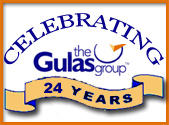Improve Communication 41% or More
© The Gulas Group 2010
Information has become the raw material on the assembly lines of knowledge workers. By improving how you track information, you improve your communication and can get better results each and every workday.
A survey of 255 companies from over 2000 individuals who participated in a Priority Working Smart with Microsoft Outlook workshop saw their communication improve 41% in a post-workshop survey. Some of the companies in the survey included PepsiCo, Xerox Corp., and FedEX. This improvement was the result of tracking what they needed do, following up when they said they needed to follow up, and doing what they said they would do each and every time.
The ability to quickly recall what you said and what your key contact said during each conversation proved beneficial in getting more done in less time. This resulted in as much as an additional 65 minutes or more of productive time each day. Not having to remember what you need to do from each conversation also relives stress and builds trust between internal and external clients.
An interesting observation from these post-workshop evaluation surveys results is how many companies and individuals were only using Microsoft Outlook as a reactive, not proactive, tool.
This occurs because today's workers are not instructed on the true value of using this type of tool to pre-plan their communication. They also don't do a very good job of showing their employees how to link communications to a follow up date, or how to link the communication to a task that is also linked to their daily to do list. It all begins with knowing how to configure the Microsoft Outlook tool box properly.
When knowledge workers do get sent to some type of Microsoft Outlook training, it typically does not produce these types of results. The reason for that is most Microsoft Outlook training is based on key stoke training and not focused on improving behaviors related to best business practices.
Here is an example of the comparison between keystroke training and improving behaviors with best practice business process oriented training. In keystroke training, the instructor will show you all the bells and whistles you can turn on or off and use.
While this is useful, it becomes distracting because in Microsoft Outlook there are so many ways to do a particular function it is very easy to become overwhelmed with too many choices. When it comes to the "to do" list in Microsoft Outlook, they will discuss all the ways to put data into the list but not review why the data is there and how to use it for both business and personal effectiveness.
In keystroke training they will also not address how to set up the "to do bar" so that the "to do bar" actually becomes a list of when to do items, prioritized for each respective day. What is missing is showing the behaviors and the philosophy to set up these correct business processes behind an effective "to do bar."
Another behavior change is found in the "to do bar's" task assign function, which links notes in a contact record in the contact folder in Microsoft Outlook. This results in proper tracking of communication.
When you attend a Working Smart with Outlook class, the focus is on improving workplace behaviors by isolating the right task with the right process and the right tool. With this philosophy, you learn why you need to use your contact folder and the respective contact records to link an individual record in order to track what you said, when you said it, and what date you need to follow up on that communication so that nothing will fall through the cracks.
That is how participants of this workshop improve communication by 41% or more. They understand who they need to follow up with on the day they need to do it. They also don?t have to search legal pads, note cards, sticky notes, message slips, business cards, or backs of envelopes to remember what they said and what their key contact said to them.
Ted Gulas is CEO of the Gulas Group which guides individuals, teams and organizations to their goals by maximizing human potential. To accomplish this Ted specializes in effective assessments, sales development, sales leadership, coaching, workload/time management, leadership, meeting and project planning, customer service plus negotiation training. To learn how to manage your workloads as a way to maximize human potential in the workplace.
|







